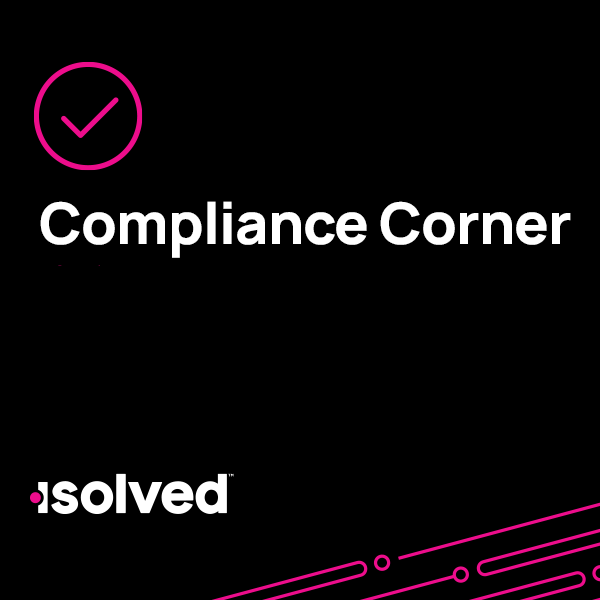Compliance Corner: 2023 HR Wrap-Up
Wednesday December 27th, 2023
Estimated time to read: 8 minutes

Every year brings unique and challenging changes to the workplace and 2023 was no exception. It feels like these changes have accelerated exponentially since the “COVID era”! This year brought pay transparency laws to several states, state mandates of paid family leave laws, issues with artificial intelligence in the workplace, great strides in employee wellness (focus on mental health), battles over a return to the office, enactment of the Federal Pregnant Workers Fairness Act and more customized employee benefit offerings.
This month’s Compliance Corner will outline how these things may affect you and what you can do about them.
Pay Transparency
Pay Transparency (or salary transparency/wage transparency) is the practice of openly sharing information about compensation with employees and job candidates. Often, this involves disclosing the salary range for job postings, and to current employees, upon request. Several states have enacted pay transparency laws with varying requirements, in 2023. By the end of 2023, eight states will have enacted pay transparency laws (as well as five cities and one county) and at least fifteen more are considering pay transparency laws. On January 1, 2024, Colorado will enact updates to their pay transparency law, and Hawaii will have a new pay transparency law (and expand equal pay amendments) going into effect.
What This Means for You
Pay transparency is becoming very popular, so if it does not affect your business directly, it most likely will in the future. Pay transparency tends to lead to greater pay equity, as companies become more accountable for implementing fair pay practices. It can also help to attract more talent and reduce “time-wasting” with job applicants, since knowing the salary range upfront will help attract only candidates who would be satisfied with the posted salary range. There are many more benefits to pay transparency, including increased employee trust, retention and engagement. Conversely, it can put stress on you, as the employer, to reformulate pay practices in a short amount of time and it can also open your company up to competitors poaching your employees.
What You Can Do
Whether you have employees in a state that requires pay transparency or not (yet), it would be best practice to review salaries and make sure that they are equitable and aligned with the company’s pay strategy. It is recommended to develop a company pay strategy and update pay ranges. A salary analysis and the development of a salary structure (to include salary ranges for each position), either done in-house or by a third party, would be very effective for your organization. Make sure to have a comprehensive communication plan to introduce the new salary ranges, when the project is completed.
State Family Leave Laws
The Federal Family and Medical Leave Act (FMLA) was passed in 1993. This gives job-protected leave to employees for medical situations for themselves and their families, as well as leave to bond with a new baby. Since then, several states have enacted family leave laws, while almost as many now have paid family leave available. In 2023, we saw a continued trend of state unpaid and paid family leave legislation taking effect. In addition to family and medical leave, two states (Illinois and California) had mandated bereavement leave go into effect. There were many updates to Family Leave Laws in 2023, and the states that will require leave laws will grow in 2024.
What This Means for You
There may be negative consequences for the mishandling of these protected leave benefits that are mandated by states. You must be very careful to comply with all of the leave laws and be constantly aware of the law updates and when they go into effect, as well as be aware of the necessary paperwork and payroll requirements that may accompany them.
What You Can Do
Be sure to keep up with new employment legislation in all the states where you have employees working. Make sure that the policies in your handbook are up to date, and that your management team is aware of the nuances of each new piece of legislation. You may want to review your company’s FMLA policy and update the pieces of it so that you can choose how to manage it.
Artificial Intelligence
The field of Artificial Intelligence (AI) involves developing intelligent machines and computer programs that can perform tasks that would typically require human intelligence. It does things that are considered “smart.” AI can process large amounts are data, beyond that of human capacity. It is becoming a field where it can recognize patterns, make decisions, and think like a human would think (judging). It is being used more and more often in the business world, and is used in numerous industries, some of which include healthcare, education, manufacturing, and agriculture.
What This Means for You
Many employee issues may arise with the use of AI in the workplace. Artificial Intelligence can lead to job displacement in some industries, which will change the structure of the workforce in many organizations. The use of AI raises some ethical issues including data privacy, algorithm bias, and the potential misuse of AI technologies. On the opposite side, AI greatly enhances productivity and efficiency so that employee time can be spent on other tasks (where an actual human is still needed). It eliminates human error and risk, can be available 24/7, can take the place of repetitive jobs and can help reduce costs.
What You Can Do
Get ready for the rise of artificial intelligence! AI is rapidly becoming as revolutionary as electricity, the automobile, the telephone and the airplane. It is important to start talking about policies and regulations concerning the use of AI in the employment process. Consider adding an AI policy to your employee handbook, so that you can control some of the effects of AI, which could involve the misuse of data and privacy issues. When using AI in applicant searching and decision-making, it is crucial to be transparent about how the AI operates and the selection process that was used. We need to ensure that the decision-making process is fair and unbiased. Since AI is only in its beginning stages, be on the lookout for government regulations on it in the future.
Emphasis on Employee Wellness in the Workplace
Employee wellness greatly benefits the employer and the employee! It boosts employee retention, increases productivity, increases profitability, decreases health risks, decreases absenteeism, improves morale and enhances the company culture, leads to health cost savings and it makes employees feel valued, supported and respected. Recently, there has been some legislation in the “workplace wellness” arena, including the addition of mandated sick leave in several states, and the Federal Pregnant Workers Fairness Act, which went into effect in 2023, requiring employers to give reasonable accommodations to employees who have limitations due to pregnancy, childbirth, or related medical conditions, so that they can remain healthy in their jobs. Many employers are also making allowances and formulating policies to accommodate menopause symptoms in the workplace.
What This Means for You
Emphasizing employee wellness can truly benefit your workplace! It may be time to take a look at your current benefits and policies and assess how they are impacting employee wellness. Would it be more beneficial to add more flexible PTO policies or work schedules, or provide an Employee Assistance Program or healthy snacks in the breakroom? Sometimes just adding one-on-one meetings to address employee concerns is extremely beneficial to an employee’s wellness. You will be competing with other organizations that are implementing many wellness tools and benefits into their workplace, so it is important to get on board with thinking about how you can enhance wellness in your workplace. It can only change things for the better!
What You Can Do
It is important to look at your current employee population and assess what is important to them – and incorporate some of those benefits or policies into the workplace, if they are feasible. Make sure to become familiar with any state or federal legislation that affects employee wellness, like mandated state sick time, family leave laws, the Pregnant Workers Fairness Act, and the /PUMP Act and make sure that you have employee policies that comply with those laws. You can give your employees a benefits survey and see what would be of best use to them. Some of these benefits are either free or inexpensive and you can save money by no longer offering benefits that employees tend not to use.
Returning to the Office
This year has seen a decrease in the use of remote workers; this is the lowest that it has been since the start of the pandemic. Employers are now taking a look at remote work and choosing to hire from local talent pools so that they will have more employees in the office. Remote work has proven to have many pros and cons for organizations. In 2023, remote job postings have declined to only 10% of all job postings (as opposed to 18% in the middle of 2022) (SHRM). Concerns about remote employee productivity and multi-state legal and tax consequences are two of the many reasons for this decline.
What This Means for You
Although there is a general decline in remote work, you must assess what is best for your industry, your culture, your talent pool and your organization as a whole, before deciding whether remote or in-office work is preferable. Some of the pros include higher productivity, fewer “office expenses” (office space, equipment, utilities, etc.), a better work/life balance, more opportunities for socially challenged employees or employees with disabilities and getting to choose from a larger talent pool. Cons may include home distractions, cybersecurity concerns, fewer social interactions/isolation (leading to potential mental health issues), lack of employee motivation, decreased productivity and decreased employee visibility.
What You Can Do
We recommend carefully assessing your workplace to see what makes the most sense economically and culturally for your organization. It may be helpful to make a list of pros and cons and give them a weight or numerical value. If you decide to make a change to your remote working policy, make sure to give employees ample time to make adjustments, as it will affect their lives. You may also want to look at your key employees and see if the work location decision may cause them to leave the company and weigh how this would impact your organization. Make sure that you look at your competition and see what they are doing. You want to make sure that you do not lose all of your employees to the competition if the work situation they offer is more desirable. Flexibility at work has become a very valuable benefit to employees, who may value this over a higher salary, so whether you decide to have remote, hybrid, or in-office employees (or a mix of that), this must be taken into consideration.
Pregnant Workers Fairness Act
The Pregnant Workers Fairness Act (PWFA) took effect on June 27, 2023. It is a law that requires covered employers to provide "reasonable accommodations" for a worker's known limitations related to pregnancy, childbirth, or related medical conditions. This Act bridges the gap between the Americans with Disabilities Act (ADA) and the Pregnancy Discrimination Act (PDA) to protect pregnant and postpartum women at work. Before the PWFA, employees impacted by pregnancy, childbirth, or related medical conditions had a right to receive accommodations in certain situations, but the area of law granting those rights was complex and inconsistently interpreted by courts, employers and attorneys. PWFA eliminates the “gray area” by providing clear expectations for employers.
What This Means for You
You, as the employer, must provide reasonable accommodations for pregnancy-related conditions unless it causes “undue hardship” (which is often difficult to prove) to your organization. You may be required to provide pregnant workers with reasonable accommodations, such as access to water, closer parking, flexible hours, and additional bathroom breaks. Employers must discuss these accommodations with the pregnant employee. With this Act, the employer cannot force the employee to take a leave of absence if the accommodation would enable them to continue working efficiently.
What You Can Do
You can make sure that your employee handbook policies are up to date, to include these types of conditions as “disabilities” that must be accommodated (if possible). Make sure that your management team is well-versed with this law so that your organization is following this federal law.
Want to start the new year off strong? Discover how isolved HR Services can help.
About Allison Hitzeman:

Allison Flanders Hitzeman (Ally), MBA, SHRM-CP, OTR/L, CHT, Certification in Compensation Studies, Senior Resources Consultant, has several years of experience in the human resource field both as a consultant and a small business owner. She has been a Human Resources Consultant with isolved since 2017. Ally currently resides in Phoenix, AZ with her husband and 2 kids, and 2 Siamese cats.
About Theresa Baker:

Theresa has over five years of experience as an HR expert. She is proud to blend her passion for HR and technology to create a remarkable experience for employers and employees. Collaborating with other HR and tech professionals on a dynamic team is what she finds most rewarding. Theresa is an Orlando native, wife, and mom of two beautiful girls, and doggy mom to her newly adopted dog, Pico.
